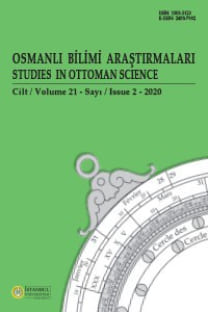Piri Reis Ve Müntehab-ı Kitab-ı Bahriye
Born in Gallipoli where the Ottomans set their first largest dockyards, Piri Reis (d.1554) is known both for his skills as a sailor and a cartographer. Kitab-ı Bahriye (Book of Seafaring) where he discussed the peculiarities of navigating along the shores of the Mediterranean sea was much esteemed by Turkish sailors. The 38 copies extant in Turkish and world libraries indicates that it was popular in the 16th, 17th centuries and even after. The present article, following an introduction presenting biographical information on Piri Reis and giving a brief description of Kitab-ı Bahriye, will focus on Müntehab-ı Kitab-ı Bahriye (A selection from the Kitab-ı Bahriye). Two copies of this manuscript are presently extant: one being in Topkapı Palace Museum Library the other in Süleymaniye Library. The manuscript studied in this article is the one kept in Süleymaniye Library (Aşir Efendi No.227). It bears the date 1645 indicating that the copy was made a century after Piri Reis’s death. The name of the compiler is not mentioned on the manuscript, but has been proposed to the work of the seventeenth century scholar Kâtib Çelebi (1609-1657). As the title Müntehab denotes, the text is heavily based on Piri Reis’s Kitab-ı Bahriye, but includes sections drawn from some other authors. The information given on islands and harbors in Kitab-ı Bahriye is summarised in the Müntehab. Charts are reduced to single pages or drawn at the edges of the pages. The major difference between Kitab-ı Bahriye and the Müntehab is that the former does not include information on the naval campaigns held by Piri Reis in Lesbos, Chios and Rhodes while the latter includes such information. This can be explained by the fact that Piri Reis’s aim was to make a book on seafaring and not on naval history. As a result of a comparison made between the two works, it can be argued that Müntehab can not be regarded as an original work, but is a text deriving from Kitab-ı Bahriye.
Piri Reis and Müntehab-ı Kitab-ı Bahriye M
Born in Gallipoli where the Ottomans set their first largest dockyards, Piri Reis (d.1554) is known both for his skills as a sailor and a cartographer. Kitab-ı Bahriye (Book of Seafaring) where he discussed the peculiarities of navigating along the shores of the Mediterranean sea was much esteemed by Turkish sailors. The 38 copies extant in Turkish and world libraries indicates that it was popular in the 16th, 17th centuries and even after. The present article, following an introduction presenting biographical information on Piri Reis and giving a brief description of Kitab-ı Bahriye, will focus on Müntehab-ı Kitab-ı Bahriye (A selection from the Kitab-ı Bahriye). Two copies of this manuscript are presently extant: one being in Topkapı Palace Museum Library the other in Süleymaniye Library. The manuscript studied in this article is the one kept in Süleymaniye Library (Aşir Efendi No.227). It bears the date 1645 indicating that the copy was made a century after Piri Reis’s death. The name of the compiler is not mentioned on the manuscript, but has been proposed to the work of the seventeenth century scholar Kâtib Çelebi (1609-1657). As the title Müntehab denotes, the text is heavily based on Piri Reis’s Kitab-ı Bahriye, but includes sections drawn from some other authors. The information given on islands and harbors in Kitab-ı Bahriye is summarised in the Müntehab. Charts are reduced to single pages or drawn at the edges of the pages. The major difference between Kitab-ı Bahriye and the Müntehab is that the former does not include information on the naval campaigns held by Piri Reis in Lesbos, Chios and Rhodes while the latter includes such information. This can be explained by the fact that Piri Reis’s aim was to make a book on seafaring and not on naval history. As a result of a comparison made between the two works, it can be argued that Müntehab can not be regarded as an original work, but is a text deriving from Kitab-ı Bahriye.
